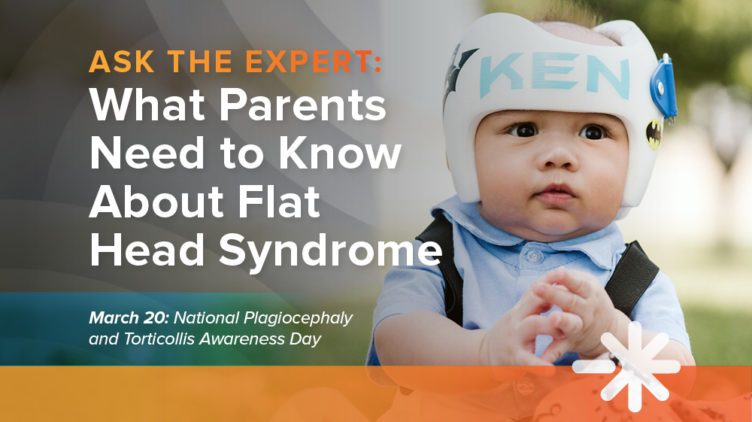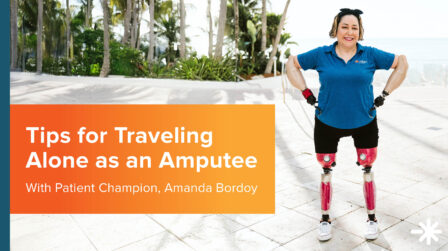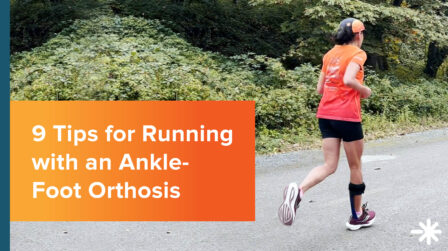What Parents Need to Know About Flat Head Syndrome

Maybe you’ve noticed a flat spot on your baby’s head. Or, perhaps your baby, or the child of a friend or family member, has worn a corrective helmet and you want to learn more. In honor of National Plagiocephaly & Torticollis Awareness Day on March 20, we are setting the record straight about what it means to have “flat head syndrome” and how it can be treated. One of the nation’s leading cranial specialists Katie Toth, CPO, sat down with us to answer some of the most common questions about the condition.
Katie Toth, CPO
Katie is an ABC-certified prosthetist/orthotist. Over her career, Katie has fit hundreds of babies with customized, corrective helmets and is an expert in the latest measurement and fitting techniques.

Ask the Expert: Flat Head Syndrome
1. What is plagiocephaly?
Plagiocephaly is the medical term for “flat head syndrome.” It is a flattening of the back of the head, typically on one side, that can range in severity. Flatness across the entire back of the head is known as brachycephaly.
2. What is torticollis?
Torticollis is a tightening of the muscles on one side of the neck, which often results in a child’s head tilting towards one shoulder and their chin rotating to the opposite side. This can occur based on how the baby is positioned in the mother’s uterus.
3. How are they related?
It is common for babies with torticollis to develop plagiocephaly due to an imbalance in their neck muscles. The tilt and rotation caused by torticollis forces the baby to lay on the same spot for prolonged periods of time. Even with physical therapy, the child may still prefer to lay on this area, causing further flattening.
4. Are they common?
Since the American Academy of Pediatrics put the Back to Sleep program in place in 1992, the number of cases of deformational plagiocephaly has increased dramatically while Sudden Infant Death Syndrome (SIDS) cases have decreased. In fact, it is estimated that up to 46% of otherwise healthy babies have plagiocephaly, and up to 90% of babies born with torticollis also have plagiocephaly.1,2
5. What are the signs, and when do they begin to appear?
Signs of torticollis would be your baby having a tilt of the head to only one side or inability to turn their head over both shoulders without twisting their torso to compensate. Torticollis is often diagnosed in the first eight weeks of life. Plagiocephaly is noticed in the first few months of life, with treatment usually starting in the 4-6 month age range after trying tummy time and repositioning techniques.
6. How do you treat the two conditions?
Torticollis is treated by a physical therapist and is best treated as early as possible to resolve the muscular imbalance. Your physical therapist will set up a treatment plan for you and will also monitor for signs of plagiocephaly. Depending on severity, plagiocephaly is treated with tummy time and repositioning, or a cranial remolding orthosis.
7. How long is treatment, and how does it work?
Babies who are prescribed a cranial remolding orthosis, also known as a cranial helmet or cranial band, are often required to wear the device for 3-6 months, depending on the severity at the beginning of treatment and baby’s age. It works by gently preventing excessive growth in the direction that is most prominent, while leaving open spaces for the flattened areas of the baby’s head to grow, forming a rounder, more even/symmetric shape.
8. What can parents and caregivers do if they notice signs of plagiocephaly and/or torticollis in their child?
Hanger Clinic is more than happy to provide a free evaluation to assess your child for plagiocephaly. If you suspect that your child may have torticollis, ask your pediatrician for a referral for physical therapy, so it can be treated as soon as possible.
9. How would you describe Hanger Clinic’s approach to care?
Hanger Clinic is patient-focused and committed to staying educated on new research in cranial remolding, while consistently collecting data to ensure the best possible outcome for each patient we serve. We value collaboration across the patient’s broader care team, from their physical therapist to referring provider. Every Hanger Clinic team member fitting cranial helmets is certified to do so and our technology is designed so most babies can be fit with one helmet that will last throughout their entire course of treatment. We provide free evaluations to assess the severity of the head shape, and with our broad insurance footprint of over 2,500 providers, we ensure all families are provided with the appropriate financial counseling prior to starting treatment.
10. What advice would you give to parents who just learned their child may have plagiocephaly and/or torticollis?
I would encourage them to reach out to their local Hanger Clinic and request a free evaluation. The earlier we see these children, the better. Your local clinic can connect you with another family, if you wish, to provide another support system during the treatment process.
Treating Plagiocephaly at Hanger Clinic
Find a Cranial Specialist
With over 200 specialists at more than 260 locations nationwide, Hanger Clinic’s network of Cranial Asymmetry Remolding Experts (CARE Network) helps ensure patients and families receive access to unparalleled care and expertise.
References
1. Mawji A, Vollman AR, Hatfield J, McNeil DA, Sauvé R. The incidence of positional plagiocephaly: a cohort study. Pediatrics. 2013 Aug;132(2):298-304.
2. Nilesh, Kumar & Mukherji, Srijon. (2013). Congenital muscular torticollis. Annals of maxillofacial surgery. 3. 198-200. 10.4103/2231-0746.119222.
Latest Updates
Subscribe to stay up-to-date on our latest posts.



